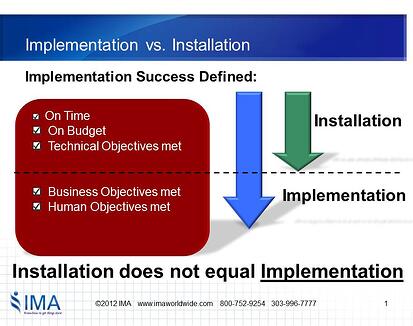How does a change management methodology help ensure value realization for technology regarding a software/technology upgrades? On a recent call with a prospective client, we heard an all too familiar scenario. Here’s how the conversation went: 
IMA: How can we help you?
Prospective Client, “We are implementing a new technology system for our customer service agents. They’ve been using a paper and pencil process up until now; they are in several different call centers around the country, and none of the agents or their managers want to make the change. Not only will the technology change, but there will be several business process changes as well as a department re-organization at the same time. The deadline is approaching fast. We are at our wits end, and we are beginning to think this project is going to fail.”
Sound familiar? It probably does. We all know there is virtually an epidemic of change in organizations today. Whether it is a new technology, a business process change, a re-organization or a combination of them all, we often hear the same sentiments. The change feels overwhelming and the change agents all the way up through the senior leaders are beginning to think the venture is destined to fail.
Luckily, as we told the client we spoke to last month, we can help. By using a change management methodology such as the Accelerating Implementation Methodology (AIM), the change can not only be successful; it can achieve the planned return on your investment.
Here’s the key: to get to solution adoption, you need to put a much greater emphasis on the human factors. That begins with having a clear definition of the human objectives for the change. These are the "behaviors you seek to see." If you aren't defining these behaviors up-front, you can't determine if the solution is adopted at the end!
The problem is that all too often everyone thinks a project ends once the change is officially launched. This is what we define as a successful installation. It’s easy to understand why getting to installation promotes a sense of accomplishment. The lights go on. The system is up and running. We are done!!
Ah, but remember: Installation does not equal Implementation! This is worth repeating, because projects that achieve installation, but fail to get to implementation are everywhere in today’s business world.
Yes, installation is very important. But it’s not enough to ensure project Return on Investment. Achieving "implementation" is the "golden ring" of user adoption and value realization.
For a project to be successfully implemented, it should be measured in 5 ways:

For our prospective client who is installing the new technology in their call centers; they need to remember this… new technology in and of itself doesn't bring value-- unless the new technology is adopted to full functionality!
While that seems obvious, the fact is that we have experienced years of new technology and the accompanying process changes without seeing an acceptable level of adoption. The investment just hasn't paid off. That is not an indictment of the quality of the technology. It's just that people have been reluctant, even resistant, to changing the way that they do their jobs.
So what is the difference from a project perspective between installation and implementation? Here are a couple of examples:
New Technology: |
|
|
Installation |
The hardware/software is launched and up and running. All new business processes have been defined. |
|
Successful IMPLEMENTATION |
There has been full adoption of the technology by users. There are absolutely no work arounds, including no use of Excel as an accepted substitute for use of the new system. |
Business Process Redesign: |
|
|
Installation |
All new processes are identified and documented. The process has been introduced into the organization. |
|
Successful IMPLEMENTATION |
Employees have adopted the new process as the way work is accomplished. |
Organizational Re-Structuring: |
|
|
Installation |
The current organizational issues have been identified and a new structure has been designed. The new structure is put in place. |
|
Successful IMPLEMENTATION |
Roles and responsibilities have been re-defined along with revised performance measures (both individual and organizational.) New job descriptions have been drafted; gap analysis is conducted to identify skill gaps; training and performance coaching are provided to close gaps; motivational issues are identified and addressed. |
As for our prospective client, yes… they have a lot of work ahead. But by utilizing AIM and realizing installation does not equal implementation… they will be on their way to realizing success.


